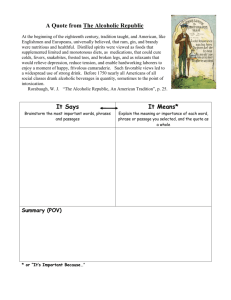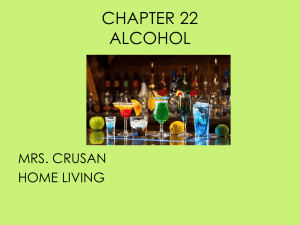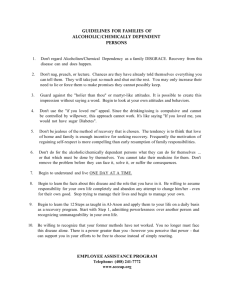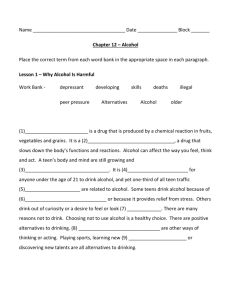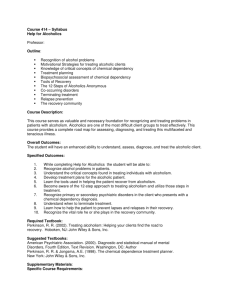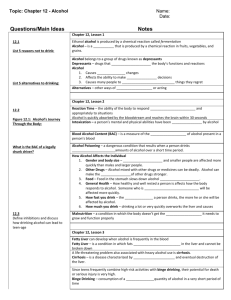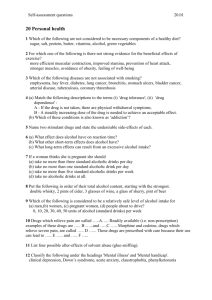499) (ID
advertisement
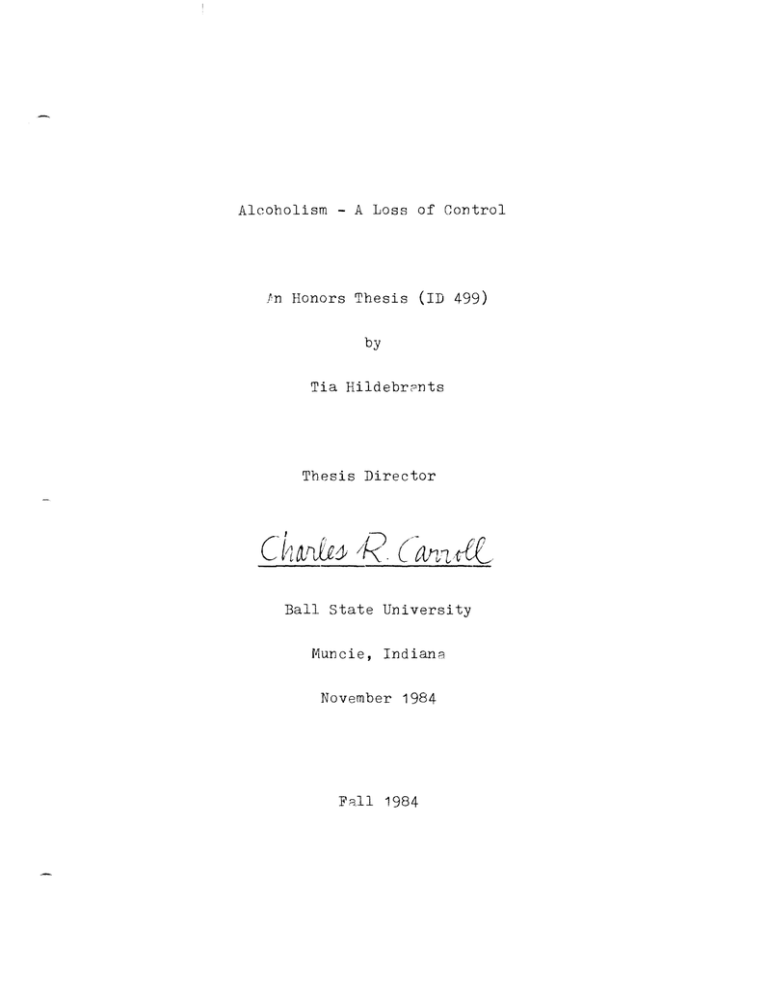
Alcoholism - A Loss of Control
fn Honors Thesis
(ID 499)
by
Tia Hildebr?nts
Thesis Director
Ball state University
Muncie, Indian8
November 1984
Fgll 1984
sv~,,·
T>' .:-~, ~ "-
TABLE OF CONTENTS
I.
Acknowledgements ••••.••.••....•.••••••••••.•••••
II.
Introduction • . . . . . . . . . . . . . . . . . . . . . . . . . . . . . . . . . • .
2
III.
Definitions of Alcoholism ••••..•.•••••••.•••••••
3
IV.
Characteristics of the Alcoholic Person2lity ••••
6
A.
E..
Denial •••••••
C.
Depression •••
D.
Anxiety •••••
Dependency.
. ..
. . . ...
.....
. . . . . .. .
..
.... ..
....
7
8
11
13
V.
Effects of the Alcoholic Personality ••••••••••••
15
VI.
Conclusion . . . . . . . . . . . . . . . . . . . . . . . . . . . . . . . . . . . . . .
19
VII.
Bibliography . • . . . . . . . . . . . . . . . . . . . . . . . . . . . . . . . . . .
21
1
ACKNOWLEDGEMENTS
I would like to extend my deepest thanks and
appreciation to Dr. Charles Carroll for his many ideas
and enthusiasm for this project.
I also thank him for
the resources he loaned to me from his personal
collection of pamphlets, books anti theses.
I would also like to thank my
the strength to finish this work.
~other
for giving me
Alcoholism
serious problem in our family and I h8ve
time dealing with it this past year.
h~d
h~8
been
a very hard
I hope that through
this work my father will recognize his symptoms and
realize that only he can help himself.
father that I dedicate this work.
~
It is to my
2
INTRODUCTION
The problems of alcoholism Rre rising in our society
at a very fast rate.
These problems are due to dependency
on alcohol and affect not only one's health, but also
interpersonal re18tionships, family relations, the career
and overall lifestyle of the alcoholic.
Many Americans
drink soci8lly but millions of
suffer daily
Americ~ms
from specific relationships with alcoholic beverages.
This suffering, however, is not confined to the individu8l
with the alcohol problem.
"It engulfs those in his family
circle and soci?l environment (1 :viii)."
problem in order to get help is also
h~rd
Discussing the
for both the
alcoholic and his loved ones becRuse somiety tends to
view alcoholism
~s
a tpboo subject.
It does not seem
appropriate to discuss another person's drinking problem.
Therefore
m~-ny
needlessly.
people suffer from the effects of alcoholism
It is estimated thst
for every person with
an alcohol problem, four fAmily members are directly affected
(21:25).
The alcoholic himself bas reduced his life expectancy
by 10 to 12 years(21 :27).
This contributes to the fact
that alcohlism "i8 the third leading cause of
de~th
in the
United states (21:164)."
This paper views alcoholism
th~t
~s
a progressive disease"
is bAsed on some psychological disorder unique to every
alcoholic.
The focus of the research, however, is to identify
and describe four basic psychological dimensions that comprise
the alcoholic personality.
3
Definitions of Alcoholism
What is it about certain people that
experience problems with alcohol use?
c~uses
them to
In his book Beyond
Alcoholism, Dan Be8uchamp suggests thpt "problem users
lack some attribute that the nonproblem drinking majority
possesses.
This attribute is in most cases termed an
ability, cRpacity or control; most commonly the alcoholic
has lost control over alcohol (11:19)."
Determining the
limits of controlling one's drinking is the common idea
expressed in the m8ny definitions of alcoholism.
Such a
definition has been adopted by Alcoholics Anonymous which
states that "an alcoholic is
8
person who cannot predict
wi th ,<=<ccLlracy what will happen when he takes a drink (21:
47)."
Other definitions include the he81th risks in-
volved in continual or excessive alcohol consumption:
Alcoholism: this cRtagory is for patients
whose alcohol intake is greate enough to
dAmage their physical health or their
personal or social functioning, or when
it becomes a prereauisite to normal
functioning. (21 :46).
Perhaps the simplest definition best describes the core
of this illness.
"Alcoholism is a disease in which the
person's use of alcohol continues despite problems it
causes in any area of life (21:50)."
All of these de-
finitions are based on the sole ch?racteristic common
to every alcoholic - loss of control.
In order to understand what alcoholism involves, one
must mAke the distinction between alcohol abuse, dependency
4
and addiction.
All three
con~itions
include impairment
in social or occupational functioning.
Alcohol abuse
does not necessarily characterize an alcoholic.
Many
nonproblem drinkers occas:ionally drink to excess, thus
abusing alcohol.
The presence of tolerance, however, doss indicate
alcohol dependency
(21:49).
Alcohol tolerance develops
as the drinker's system continually requires more alcohol
than previously consumed to achieve the same physical
and mental effect on the body.
In this C(lse the drinker
will consume more alcohol not because he wants to, but
because his system physically requires more.
At this
point control is lost.
Evidence of 8.1cohol addiction includes "the
appear~mce
of withdrawal symptoms" and the in8bility of the drinker
to go one day without drinking
(21:48).
One exception
to drin:,cing everyd .ay is the variety of alcoholism known
as periodic drinking.
In this instance, "an individual
may go for weeks or months without drinking and then
has a very severe drinking episode
(25:10)."
drinkers also suffer withdrawal symptoms.
Periodic
These symptoms
may include short-term amnesi(l or memory blackouts,
severe headaches, nausea, dizziness, shaking, sweating,
confusion and talking about visions and voices
do not exist (1:77).
th~t
The more chronic drinker's body will
also undergo "circulatory changes with congestion and
h
hemorrjages resulting from stagnation from slowing down
of the blood vessel current
(12:8)."
5
An
~lcoholic
C8n
two types of drinkers.
be further c18ssified as one of
The more common hAbitual excessive
drinkers "become intoxicated more than 12 times a year or
are recognizably under the influence of alcohol more than
once a week, even though not intoxicated (21:48)."
The
second type of drinker, the episodic excessive drinker, only
drinks as often ps 4 times a year to excess (21:48).
Even
though an episodic excessive drinker drinks much less than
the habitUAl excessive drinker, both
both have lost control of their
~re
~bility
alcoholics because
to consume alcohol.
6
ctaracteristics of the Alcoholic Personality
A considErable number of interacting factors must
combine to explain why any particular person drinks.
The
problem in detecting and treating alcoholism is that no
two pecple will have the same combin8tion of characteristics.
Dan Beauchamp adds that "alcoholics share non e of the
normal or healthy motives of the vast majority of social
drinkers
(11:40)."
The social drinker drinks for pleasure,
relax!E,§,nt, recreation, even taste.
~s
dependent on alcohol
SO
The alcoholic, however,
his entire attitude is reversed.
Instead of drinking to complement some activity or situ;:;tion,
the alcoholic drinks so that he may endure the same activity or situation.
Due to this dependency on alcohol,
"the alcoholic personality is the result of alcoholism, not
the cause (23:88)."
..A,ccording to Dr • Abram Benn et, Alcoholism should be
considered as a symptom to some underlying personality
disorder
(12:7).
If this is true, then the developing
alcoholic personality may have as its basis this same
underlying personality disorder.
The question that arises
noW. is, "Wh2.t is that underlying disorder?"
A possible
answer is the combination of emotional, mental and
physical factors found in loneliness, fear, esc?pe and
poor emotional control (16:6).
Loneliness may result from
having :few close :friffinds, moving away from familiar
surroundings or
sep~ration
from loved ones.
The shy
alcoholic may also gain a false sense of self-confidence
from the effects of alcohol on his body and mind.
7
Problerrs at work 8nd with interpersonal relationships
may be too great
in the eyes of the alcoholic to confront
without the help of alcohol.
It is the belief of this
author that four specific ch8racteristics may greatly
contribute to the fear, loneliness and
v~tious
other
problerrs of the 8lcoholic.
Denial
The first and foremost of these ch8racteristics is
denial.
"All alc:oholics deny their problem (14 :47)."
They do so because they do not perceive their drinking as a
problem, much less an illness.
Dr. Pbr8ham Twerski believes
that
Deni?l is generally unconscious; that is,
the person is unaware thRt he is doing it.
Denial is one of the defense mechanisms
referred to in psychology as one of a
person's unconscious mechanisms. It is
present in many emotional disorders, but
hardly anywhere as obviously as in the
alcoholic (25:30).
By denying his problem, the 8lcoholic builds a defensive
barrier around his emotions so that society's attitudes
and the "cold, hard truthM c8nnot hurt him.
theory the term hidden
~lcoholic
From this
has developed.
This term
me--ons th,t lithe alcoholic denies his problem and conce"ls
himself because society stigm~tizes his condition (11:49,
21 : 189)."
1<~ventu?lly,
2S
if to prove society wrong, the
drinker is "trapped in the ultimate lie: he says,
'I am
not an alcoholic,' then keeps on drinking to prove he
handle liquor (17:29)."
rr'his attitude results in
:::>
c~
8
vicious circle with 8,ccusations and pressure from
society resulting in more drinkine; by the alcoholic
whir-h again ea'l:rns more disapproval from society.
Until
denial is in some way overcome, a sincere effort at
recovery is impossible (25:32).
Dependency
According to Dr. How8rd T. Blane, author of The
Personali ty of the Alcoholic,
"dependency, 8,nd diffi-
culties with it, has been noted by many observers to
play a cruci81 role in the personality of the alcoholic
(14:14)."
Alcoholism exists when any normal function
becomes dependent on 8lcohol, regardless of the quantity
consumed.
If the dependency factor were misming,
alcoholism would not
exist~
Therefore, dependence on
alcohol not only results in alcoholism but becomes the
center of the alcoholic personRlity as well.
Dependency on alcohol mRy be mental, physical, or
a combination of both.
Dependency may be defined in the
following way:
The interaction between a living org~nism
and a drug, characterized by behavioral
and other responses that always include a
compulsion to take the drug on a continuous
or periodic basis in order to experience
its psychic effects, and sometimes to avoid
the discomfort of its absence (1 :38).
Most alcohcl:>lics were social drinkers before they became
alCOholics.
The gradual inclination toward dependency
results from a wide variety of situations.
Pressure on
the job may lead the drinker to believe th.'lt he must have
9
a drink before tackling the problem pt h?nd or speaking
wit~
the boss.
Also, as responsibilities increase, whether
by m?rriage, a new child, or even expanding his business,
the alcoholic m?y respond with anxiety
~nd
tension.
In
this situation, "a surrender of dependency CAn occur,
the man turning increasingly to alcohol and relinquishing
adult responsibilities (14:16)."
Should the alcoholic
come tc terms with his illness, he is once again tempted
by society to return to dependency.
The alcoholic's decision
to seek help m?y be "influenced by society's negative
attitude toward open avowals of dependency in men and
by society's tendency to equpte independence and masculinity (14:33)."
Alcoholism is yet to be fully accepted
as a disease, and until it is accepted, society mqy
continue to condemn the alcoholic, thus the more vulnerable drinker may return to the security of alcohol instead
of seeking help.
How, then, can one recognize the beginning of dependence?
Dependence c?n first be detected in the drinker's
attitude toward
9
lcohol.
If he crumot, or thinks he
cannot, go somewhere, meet someone or do something without having a drink first, he is becoming dependent on
alcohol.
If this attitude has already developed, the
drinking pattern must by observed to confirm dependency.
If, with time, the drinker takes 3 drinks wh en he previously
took one in order to endure the same situ?tion, his body
is becoming chemically dependent.
Consuming more alcohol
to achieve the same effect as before with less alcohol is
10
the characteristic of addiction known
8.8
tolerance.
Every person's central nervous system
when continu?lly subjected to a depressant chemical, will eventually
8ccommod?te 2nd adapt itself in such a
manner th8t the same amount of chemical
will no longer have the same effect (25:
11) •
However, the alcoholic, his family And friends m8Y all
deny
e~ch
of these characteristics.
In th2t case, all
personc who interact with the alcoholic, as well as the
alcoholic himself, may finally recognize
depen~ency
the inconsistent beh?vior of the alcoholic.
to authors
Je~n
by
According
Kinney and Gwen Leaton, the active
alc:>holic c:::mnot be depended on.
"Sometimes doing wh8t
is expected, and dOing it beautifully, the next time he
may fail completely offering later the flimsiest excusp.
To add insult to injury, he or she gets furious at you
for beimg disappointed, or annoyed, for not understanding
(21:146)."
The attitude, tolerance level and inconsistent
behavior may all exist with still no recognition of an
alcohol problem by the alcoholic.
Once again, the
alcoholic must first overcome denial of a potential
problem before admitting his own symptoms of this disease.
It is
c~uc~al
for the alcoholic to realize that admitting
dependence on alcohol will not result in humiliation by
family and friends.
Those aware of hms illness will be
very supportive of the alcoholic who seeks help.
not be less of
be nore of one.
?
He will
man for ::1dmitting his problem; he will
11
Depression
Alcoholism is a form of depression.
The alcoholic
experiences two types of depression - that of his physic81
nervous system !:'nd th8t of his mental state.
"Depression
on the nervous system is the principal 8ction of alcohol.
The first mental processes affected are those dealing with
self-restraint.
In general, the central nervous system
effects are proportion~l to the blood alcohilil level (12:
9).'1
This reaction occurs in all persons who drink.
Alcohol is a drug and, like other drugs, it alters normal
physical and mental functioning.
blood
level may be
~lcohol
cases of alcoholism, the
reached such
~
The reference to the
misle~ding,
~lcoholic's
however.
In severe
tolerpnce may have
point that only after consuming large
quantities of alcohol do his physical and mental capabilities
begin to decrease.
Unlike the depression of the central nervous system, the
depressed mental state of the alcoholic cannot be so easily
defined.
The depression experienced by the alcoholic may
be better understood if compared to the characteristics
of a depressed person.
According to Dr. Howard T. Blane,
A seriously depressed person feels wurthless and unattuned to living: he suffers
from loss of appetite and is unable to
sleep.
Preoccupied with thoughts of selfdestruction, obsessed by sinfulness to the
point that he res~onds little to those
around him (14:39).
Of course, not all alcoholics suffer from an extreme case
of depression such
~s
this.
It is true, however, that
12
many alcoholic bouts often begin when "the alcoholic
senses the imminent upsurge of depressed feelings (14:
40)."
What, then, cuases these feelings which convince
the alcoholic to succumb to that first drink?
person suffering
fro~
Like the
depression, the alcoholic is
~
especiELlly st.yceptible to pressures and demands from
his environment.
When the pressure intensifies, the
depressed person ricsorts to thoughts of incompetence.
He does not believe in himself or his CApabilities, therefore, the pressure
m~y
begin to affect his d8ily activities.
The alcoholic, however, seeks relief from pressure through
alcohol.
He
h~8
the need for
environment (21 :11-12).
~
feeling of power over his
By drinking, the alcoholic
believes hre has overcome the pressure, when in reality that
first drink now requires successive drinks.
It is with
these successive drinks that the alcoholic loses his "power"
and control ano, like the depresseo person, must struggle
to prevent his solution to the origin8l pressures and
demands from grec-tly affecting his normal functioning.
Also, the depressed person and the alcoholic often
blame themselves for unpleasant situ8tions caused by others.
They are unable to express anger toward another so they
turn it against themselves, transformi1!lg it into depression.
Basically, "the depressed person is an angry person (14:39)."
The 8lcoholic punishes himself with guilt feelings and
then turns to alcohol to rid himself of this self-inflicted
pain.
The
~lcoholic
does not realize that he is harming
himself mentally Pmd physically by drinking.
He only sees
13
alcohol as an escape route from problems and pressures.
Until a problem ~rises th::lt the 8lcoholic cpnnot "cure"
with alcohol, he will forever remain pn alcoholic.
Anxiety.
The finpl common characteristic of the alcoholic
personality is anxiety.
Anxiety often results if the
alcoholic h2rbors unjustified feelings of in8dequacy
which convince him that he is also inc8pable of coping
wi th the m~my stresses of everyday life.
"He may feel
so insecure about l1imself th;:<t many rpther minor challenges appe8r to he so overwhelming that he feels
compelled to escape them all, and often that escape is
into the anesthesiFl or oblivion of alcohol (25:58)."
These feelings of inadequacy may cause much frustration
fur the alcoholic.
He seems dissatisfied with himself,
impatient and demanding of otbers (21 :74,17:27).
alcoholic "feels very vulnerable to the
worl~.
The
Nursing a
drink seems an appropriate way of handling his discomforts.
Alcohol is doubly attractive because it works quickly
(21 :74)."
I'
I
Unfortunately, this frustration is su#essed by many
alcoholics and eventu311y may be expressed as anger and
aggression.
According to Dr. Howard T. Blane, "anger is
born of frustration - and its unrelenting persistence is
du-e to frustration that is continual (14 :35)."
The alcoholic
may initially express his anger by making demands
his dependent needs be satisfied.
th~t
His ahger may also
appear as "criticism of ot-hers for what they have not done,
14
or what they have not given to the alcoholic
(14:40-1)."
If the alcoholic feels that his demands are not
met, he may become retaliatory, defensive, quick-tempered
and vengeful.
The result is deeply buried frustration
that surfaces as hostility and violence.
Open aggression
is most likely to occur with those "toward whom the alcoholic
feels close and to\Jard whom he frequently turns to gratify
dependent needs
(14:38)."
This situation may cause intense
psychological problems for family members and friends of
the alcoholic.
r;;any often blame themselves for the anger
that has been aroused in the alcoholic.
They try to
ple8.se him and he abuses them even more.
In this case the
alcoholic, his family and friends must all seek help.
is vitally
imp~rtant
It
that those affected by alcoholism
understand that "the alcoholic is powerless over aloohol;
it is all-powerful over him
(25:39)."
The alcoholic
doesn't realize what he is saying or doing and those
involved must learn to accept his thoughts and actions
as consequences of this disease called alcoholism.
15
Effects of the Alcnholic Personality
The effects of alcoholism are as many and as varied
as the char8cteristics of the disease itself.
Most
importantly, alcoholi sm is a progressive di sep.,se.
gression means that
~even
Pro-
after years of abstinence, if
an alcoholic starts drinking again, he is immediately at
the mercy of the drug ••• therefore, eliminating the cause
does not eliminate the sickness (17:21)."
Alcoholism is
not a disease that can be cured with drugs because
alcohol is itself a drug.
It CRn only be treated with
abstinence resulting from the alcoholic's admittance of
his inability to control alcohol (21:183).
Unfortunately, however, only 5 to 10% of all
alcoholics fully recover from this illness (18:22).
This
indicates that the overwhelming majority of alcoholics,
their families and friends continually suffer from the
consequences of thi$ disease.
The alcoholic experiences
two very different effects of the alcohol itself.
After
the first few drinks the alcoholic feels tension slip
away to be replaced by tr'::tnquili ty and pleasure.
The
drug relieves unpleasant mental thoughts and feelings,
thus reinforcing the alcoholic's belief that alcohol is
good and couldn't possibly be the origin of a disease.
After consuming a certain amount of alCOhol, however, the
alcohol:Lc r s frame of mind changes drastically.
"Alcohol. ••
can itself produce a very depressing effect on mood and
the person becomes prey to all sorts of doubts, miseries,
suspicions, and general gloom (1 :74).~
This pain accentuates
16
with each drink.
The alcoholic often feels depressed
and guilty and as a result drinks even more which
eventu81ly may result in physical illness in addition
to his mental anguish.
Tte fp.mily members of the 8lcoholic also suffer
their cwn consequences of p.lcoholism.
The hardest concept
for thcse close to an alcoholic to accept is th?t "the
alcoholic has no control over alcohol; those around him
have nc control over the alcoholic (25:43)."
The relatives
and friends of the alcoholic must realize thp.t they have
tn no
~ay
caused the alcoholism of their loved one.
Could a family member caUSE? diseases such ?S cancer and
diabetes?
If alcoholism is treated as a disease, the
answer is equally simple - no.
In the case of alcoholism,
however, family mf;mbers could easily reinforce alcoholism
without realizimg it.
Family members often try to shield
the alcoholic from excessive pressures and tensionproducing situations in hopes
will subside.
th~t
the drinking episodes
Instead, the alcoholic becomes even more
unsure of himself when he eventu8.11y does have to deal
with stressful situations.
Sever?l specific problems may arise in families with
young children where one of the parents is alcoholic.
The
Royal College of Psychi?trists reports thp.t "the disabilities which affect the children of a family in which there
is a drinking problem can be dev8stating.
The child mpy
have to endure the perpetual rowing between his parents
or be witness to scenes of
physic~l
violence (1 :61).
'I
A
17
child will often
~xperience
th8t his parent drinks
feelings of guilt.
bec~use
He feels
he has been "bAd."
The
innocent child's simple solution is to try his hardest
to be good.
If this fails, the child "may spend a lot
of time trying by various behaviors to control or
ch~nge
the drinking pattern of their parent, and inevitably
failing, often come to feel as though they are 'failures'
ahe3.d of time (21 :157-8)."
For a young child to feel
responsible for the alcoholism must indicate the severity
of this dise8se.
A child may also experience a fear of
abandonment (21 :157).
He may have too often waited for
or been forgotten by his alcoholic parent who promised
to pick him up after school, music lessons or the football
game.
A
he~lthy
parent-child relationship must h 0 vP trust
and honesty from both involved.
If the child cannot trust
his 'P8rent, then only his parent's alcoholism can be"
blamed for the abnormal and unhealthy conditions the
child
~ust
live in.
This situation may worsen if the child
begimB to feel anger and h8.tred in response to the actions
of his drinking parent.
Finally,::; child and his
accomplishments may hav,: been neglected by the alcoholic
parent.
anger, he
If the child doesn't respond with guilt, fear or
m~y
seek outside approval.
They may becomp ohsessive over8.chievers,
craving success at any cost to relationships of any kind ••• Their expectRtions of
themselves, and consequently of others,
often destroy their relationships with
those around them much as alcoholism does
( 21 : 1 58) .
18
Children are very sensitive to the feelings of others,
especially their parents.
When 81coholism has these
effects on children, the consequences m8Y deeply affect
the child in the formative years as well as in the
future as an adult.
~~coholism
is one of the few diseases that seriously
affects the person with the disease as well as family
members and friends close to the alcoholic.
It is also
one of the few diseases that CAn never be completely
cured.
Alcoholism is a chromic, progressive illness
with many varied effects.
The drinking may stop and the
alcoholic mpy seek help, but the effects of this disease,
like alcoholism itself, will never disappear.
The
alcoholic can only hope that he as well as those affected
by bis disease, will be able to cope with the fear, anger,
frustration and the m?JJY other emotions involved with
alcoholism.
19
Conclusion
Alcoh01ism is a disease which results when one loses
control of his ability to consume alcohol.
"~he
alcoholic cannot consistently choose whether he shall
drink Dr not.
There comes an occ?sion when he is power-
less, when he cannot help drinking (11: 28) • "
}\ lcoholi sm
is often hard to define and distinguish from social
drinkirg by the unknowing individual.
There is "certainly
no unique alcoholic personality (1 :110)," but when
examined more closely, alcoholism m8Y be distinuish8ble
by four common characteristics: denial, dependency,
depression and anxiety.
These ch?r!'1cteristics are
important factors in the origins of alcoholism
as in the treatment of the disease.
~s
well
These chRracteristics
combine with those unique to each alcoholic resulting in
serious emotional effects on the alcoholic, his family
and friends.
Those closely involved with the alcoholic must
realize thc=,t there is absolutely nothing they can do to
change the alcoholic (25:xiii).
They can, however, seek
help for themselves so that they may learn to cope with
their own anger, frustration and pain.
alcoholic in the
f~mily
m"y
pro~oke
Na tUll'111y ;in
feelings of anxiety,
tension and hostility between family members
alcoholic.
~hd·the
To help themselves and tl1e alcoholic, the
family members must accept the f8ct that "the decision to
drink away these or any other uncomfortable fec~lings is
no one else's but the alcoholic's (25:ix)."
The alcoholic
20
himself chooses to drink; he is never forced to drink
by others.
The root of the disease called alcoholism
m8Y be found in the answer to the question, "Why does
one choose to drink at all?"
Medic21 experts base the
cause of alcoholism on some existing personality disorder.
This disorder is in return
b~sed
ch2racteristics of the alcoholic.
on the personality
The many definitions
of alcoholism and accompanying personality ch8racteristics
coupled with the complexity and uniqueness of the disease
in eact alcoholic results in
8
very confusing and often
misunderstood conception of alcoholism.
The one element common to every alcoholic is the loss
of control over alcohol.
com~on
The only answer to alcoholism
to every alcoholic is admittance and acceptance of
alcoholism as a controllable illness.
Within every person there is a nucleus of
self-respect and dignity which, no m8tter
how deeply concealed, exists obstinately.
There comes a time when a person discovers
th~")t he dare not be anything less than th.':lt
which he can be, and at such a time, the
miracle of sobriety can occur (25:xvii).
Only when 8n alcoholic reaches the point in his life
when even plcohol will not solve his problems will he
stop drinking.
Only when he openly admits and accepts
his illness will he be able to seek and accept help.
21
BIBLIOGRAPHY
1. Alcohol and Alcoholism. Itoyal r,ollege of Psychiatrists.
Mew YOl'~ess, 1979.
2. Alcoholics Anonymous. A Member's-Rye ViFw of Alcoholics
Anonymous. New York: Alcoholics Anonymous World
Services, Inc., 1970.
3. Alcoholics Anonymous. This is j\.A. 1984 ed. New York:
Alcoholics Anonymous World Services, Inc., 1953.
4. AI-Anon Family Groups. Alcoholism The Family Disease.
New York: AI-Ano:iJ'1TamlIy Group lieai"lq uarters, Inc.,
1972.
5. AI-Anon Family Groups. Alcoholism A ff;erry-go-round Named
Deni~l. New York: AI-Anon ]'?mlIy Group Eeadquatters,
Inc., 1969.
6. AI-Anon .Family Groups. Detachment. New York: AI-Anon
Family Group Headquarters, Inc., 1983.
7. AI-Anon Family Groups. Freedom From Despair. New York:
AI-Ahoti Family Group Headquarters, Inc., 1983.
8.AI-Anon Family Groups. A Guide for the Family of the
Alcoholic. New York: AI-Anon FamlIy Group Hea5quarters, Inc., 1983.
9. ,~l-Anon Family Groups. Just For Today. New York: tl-Anon
Family Group Headqu;~rters, Inc., 1972.
10. AI-Anon Family Groups. So You Love an Alcoholic. New
York: AI-Anon FamITy Group Headqu8rters, Inc., 1983.
11. Be8uchamp, Dan E. Beyond Alcoholism. Philadelphia, PA:
Temple Universlty Press, 1980.
12. Bennet, Abram "Siting, JVi.D. Alcoholism and the Brain.
New York: Str8tton Intercontlnental MedlcaI Book
Corp., 1977.
13. Birnbpum, Isabel 1'1. and Elizrtbeth S. Parker, eds. Alcohol
and Human Memory. Hillsd8le, New Jersey: Lawrence
Erlbaum Assoclates, 1977.
14. BIE.ne, Howard T., Ph.D. rrhe Pers.nrtlity of the Alcoholic:
Guises of Dependency. New York: Harper & Row
PubIlshers, rgBS.
15. Budgen, I{jark. ~'Seeking Compensation for the Disabling
Drink." fi;aclean's, 7 November 1983, p.65.
16. Channing L. Bete Company. ~oholic in the F?milYL 1983
ed. Sou ttl Deerfi f:::;ld, Mh: Channing L. Bete Co., 1977.
17. Costales, Claire and Jo Berry. Alcoholism: The Way Back
to Reality. Glendale, California: GIL Publications,
1980.
18. ?i tzgerald, Kathleen Whalen. "Living with Jellinek's
Dis e a s e. 11 New s week, 17 0 c to b e r 1983, p. 22.
22
19. Janowitz, Horris. The Last Half-Century. Chicago:
Un i versi ty of Chicago Press, 1978.
20. .John son, Raymond B. and William N. JJukash. Med ical
Complications of Alcohol Abuse. Summary of the
1973 tmeric?n Medical Association Washington
Conference. AMft, 1973.
21. Kinney, Jean, M.S.W. and Gwen Le~ton. Loosening the
Grip, 2 Hpndbook of Alcohol Inform8tion. C.B.
NosbY',Company, 1983.
22. Mackfmzie, Hilary. "A Subtle Measure of Alcohol Abuse."
Maclean's. 7 November 1983, p.65.
23. O'Reilly, Hane.
"New Insights into Alcoholism." Time.
25 April 1983, pp.88-89.
24. Pattison, E. rr:ansell, Mark Sobell and Linda Sobell, eds.
Emerging Concepts in Alcohol Dependence. New
York: Springer Publishers, 1977.
--25. Twerski, Abraham J., M.D. Caution: Kindness Can Be
Dangerous to the rlcoholic. Englewood Cliffs,
N.J.: Prentice Hall Inc., 1981.
